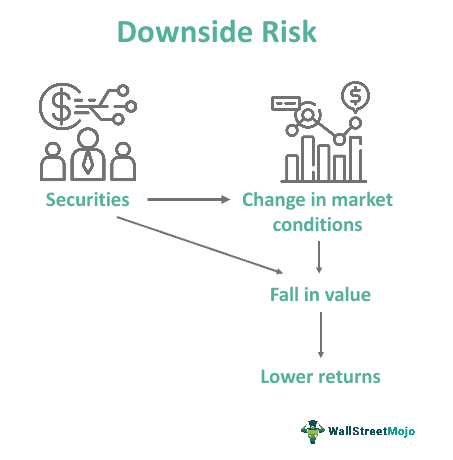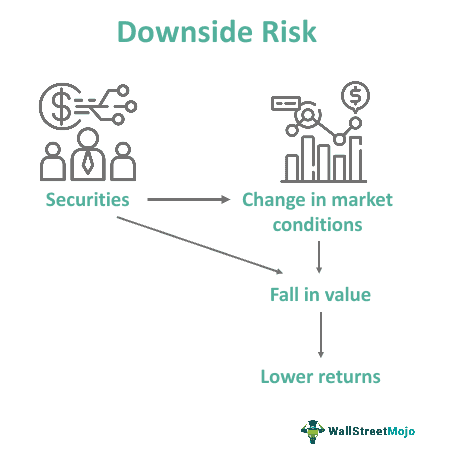Table Of Contents
Downside Risk Meaning
The downside risk is a statistical measure that calculates the loss in value of the security due to changes in market conditions and is also referred to as the uncertainty that the realized return can be much less than the anticipated results. Put it helps in quantifying the worst-case loss that an investment can lead to if the market changes direction.

Financial products are unpredictable in times of distress like the 2008 economic recession or the 2001 dot com bubble; the volatility and the correlation between the asset classes increases. Most often than not, it catches investors off-guard, leading to huge losses and catastrophic events. As a preventive measure, downside risk helps eliminate or prepare better for such scenarios.
Downside Risk Explained
Downside risk refers to the possibility of the portfolio value coming down or performing lower that the expected benchmark. This may be due to various reasons like adverse market conditions, volatility, natural calmilty, inefficiency in business operations, etc.
The decline in the asset value results in losses and erosion of the investment returns. Thus the very purpose of investing the funds is not served. Every entity and individual should make downside risk calculations and assess the risk of a fall in a portfolio or investment value to protect their funds from adverse scenarios and financial harms.
However, such a risk will always exist to some extent. It is not possible to totally eliminate it. Proper understanding and financial knowledge helps in mitigating or controlling it to a great extent so that the money invested gives some returns and there is a balance in the financial performance of the business.
Components
The following are the essential components of a downside risk metric:
#1 - Time Horizon
The most critical parameter to analyze any risk metric is the time horizon. This factor becomes even more critical for downside risk. The time horizon helps in limiting our analysis for a particular duration of time, making our downside risk calculation more precise and models more robust. It should be essential to include proper sample space to make sure the time horizon you selected is unbiased and is free from cyclic deviations.
#2 - Confidence Interval
The downside risk measures study is based on statistical measures. Hence it becomes essential that a proper and definite confidence formula is selected as all further calculations will be based on it. This parameter should be defined based on the investor's comfort level or the institution conducting the analysis. No definite number is right or wrong, but a benchmark based on which you decide your risk-taking ability.

Formula
There can be many ways to calculate the downside risk. You can use standard deviation, expected shortfall, or value at risk, which has multiple methods like historical simulation, variance-covariance, etc. The aim is to calculate the maximum you can lose based on the sample space (underlying data) for a particular time horizon and confidence interval.
For the variance-covariance method, downside risk (VAR) is calculated as:
Example
Let's see a simple example to understand it in a better way.
Consider the example of a company ABC whose stock is trading at $ 1000. The following table lists the monthly returns for one year.
| Month | Returns |
|---|---|
| Jan | -12% |
| Feb | -5% |
| Mar | 6% |
| Apr | 7% |
| May | 3% |
| Jun | -2% |
| Jul | 15% |
| Aug | -8% |
| Sep | 10% |
| Oct | -4% |
| Nov | 9% |
| Dec | -3% |
Let’s calculate the downside risk of this stock based on past returns, and to keep matters simple, we will calculate using the mechanism of the historical method. Let’s decide the confidence interval and time horizon.
- Confidence interval: 75%
- Time horizon: 1 year
Returns in sorted order

Calculation of Max Loss

- Max Loss = 3

Arranging the returns in sorted order, we will focus on the bottom 25% returns ( max loss), 3 ( 75% of 12). Hence the cutoff will be the 4th return. In simple terms, with a 75% confidence interval, we have calculated the downside risk to be -5%.
Refer to the Excel Sheet given above for detailed calculation.
Advantages
Just as every financial concept has advantages and disadvantages, so does this. We'll now try to identify the benefits.
#1 - Helps in Planning for the Worst-Case
If you fail to plan, you are planning to fail. Downside risk measures enable you to prepare for the worst-case scenario by understanding how much investment can lead to losses if the projected view turns out wrong. It is no common fact that investments are made for returns and meeting market free rates, often defined by US treasury bills. But there can be scenarios when things don’t go as expected because of news or an event not reflected in the market. Consider the example of Yahoo, a search engine giant of the early 90s without any competitor. Everyone was hopeful that this stock would be a multi-bagger but little did everyone know that a new market leader (Google) was in the making, and yahoo will be displaced. Had there been downside risk control deployed in the systems, losses would have been much less.
#2 - Deciding Hedging Strategies
As explained above, the downside risk is more about preparing when the events do not turn out as expected. Such estimation helps identify when to come out of an investment. As they say, keep your profits but book your losses.
Disadvantages
Some of the important disadvantages of the concept are given below.
#1 - A false sense of security
Downside risk is a statistical technique that tries to predict based on past data patterns. Its complexity varies from asset class to asset class. For a simple financial product like equity, it could be as simple as trading prices. For intricate work like credit default swaps, it depends on many parameters like underlying financial bond prices, time to maturity, current interest rates, etc. The model you are using can work 99 times but can fail once too, and most often, this will happen when volatility is high, or markets are crashing. In short, it will fail when you need it the most. Hence due to model risk, downside risk can provide you with a false sense of security.
#2 - Inconsistent results across models
Downside risk protection is as good as the model used. Based on the underlying process used, there can be variations in the work even though the underlying assumptions and the sample are the same. This is because each downside risk metric mechanism has its implicit assumptions, leading to a different output. For example, both historical simulation and Monte Carlo simulation value at risk mechanisms, but the result derived through them based on the same underlying data can differ.
It is a good practice to consider the various advantages and disadvantages of this any financial concept and then go for investment. Finance professionals in such cases provide good financial advice since they are well aware about the different methods, rules and latest financial trends in the market.
How To Mitigate?
Mitigating the downside risk involves strategies and practices tha help in controlling the potential loss or negative outcome. Let us identify some procedures to do the same.
- Calculating downside risk helps one identify the correct hedging strategy. Investors and institutions should understand the financial product they are dealing with and then select a suitable downside risk protection metric per their comfort and capability.
- Each asset class has a different downside risk. For vanilla financial products like equity and fixed income, the downside risk is relatively easy to calculate and limited. However, for financial derivatives like options or credit default swaps, the downside is challenging to figure and unlimited.
- Diversification of investment is a very effective method to control this risk, where the investments are spread across various asset classes, sectors or regions. In this way the impact of adverse effect on a particular asset class is reduced because the risk is spread in different assets. The loss of one asset is compensated by the profit from another.
- Stop-loss orders also provide an effective way to manage downside risk mitigation while trading. In it, the trader sets a predetermined price level. The investment gets sold off automatically if the price falls below that level. Thus, triggering a sale limits the possible loss before a further fall in the investment value.
- It is necessary to monitor the investments and if required, rebalance the portfolio by identifying the changes in market conditions, risk profile and performance of the assets. Periodic rebalancing and adjusting the asset allocation helps in controlling the risk and aligning the investment goals with the level of risk tolerance.
- Investment in defensive assets that remain relatively stable even during heavy market fluctuations is a good method to control downside risk. They are less volatile in nature.
However, it is not possible to eliminate any investment risks. But it is always possible to devise ways and means to control and mitigate the losses by implementing the above strategies.
Downside Risk Vs Upside Risk
The above two terms refer to different aspects of the possible outcome of an investment opportunity of performance of a business.
- The former refers to a unfavorable outcome of a business opportunity or losses, whereas the latter refers to a positive or favorable outcome of a business or investment opportunity.
- The former shows that the potential investment may perform lower than the expectation level and the latter shows that the potential investment may perform higher than the expectation level.
- The former depends on factors like volatility of the market, economic slowdown, inefficiency in business operation, changes in rules and regulations, etc, but the latter depends on innovation, successful business strategies, etc.
- Businesses try to devise methods and downside risk mitigation strategies to protect themselves from downside risk and losses. In contrast, the company and investors seek opportunities with higher upside potential to generate higher profits.
Thus, it is essential to identify both the upside and downside risks and then make informed decisions. Both risks should be considered to take a balanced approach and manage the risk. Balancing the two is crucial in any business.

